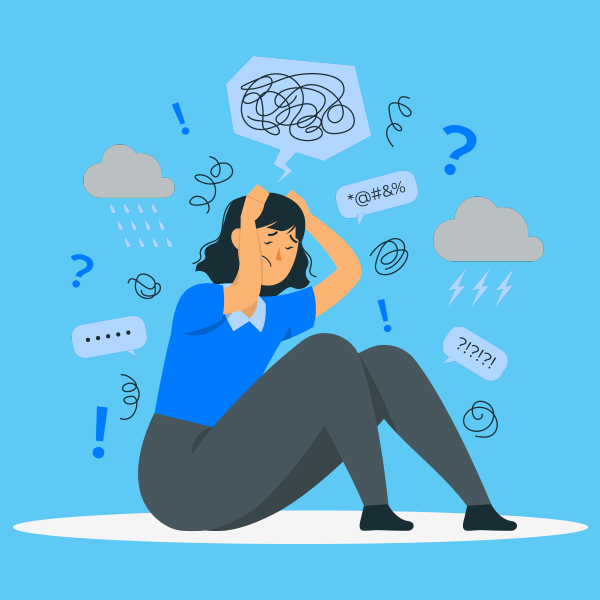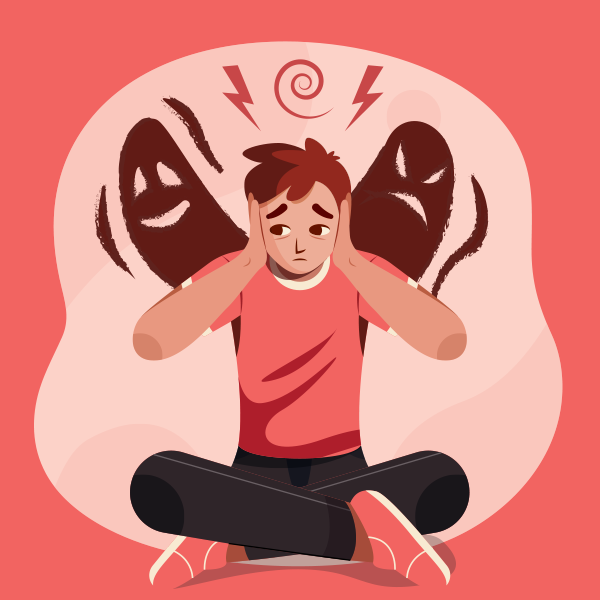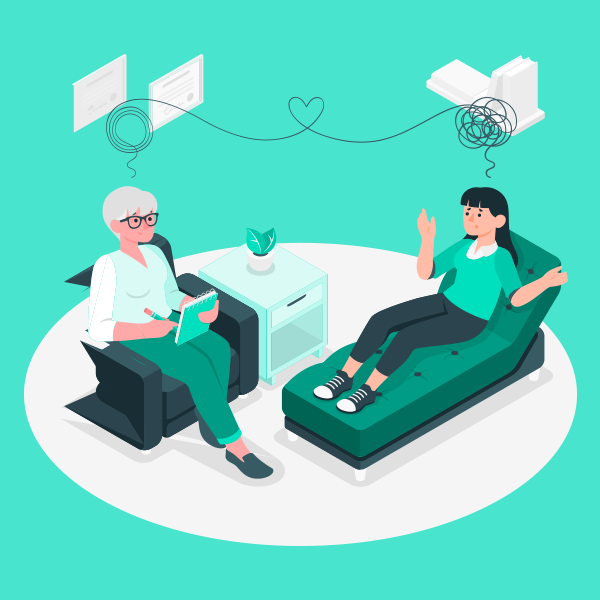Millions of people across the globe experience anxiety, and panic disorder is a specific type of anxiety that can significantly impact a person’s life. Panic disorder and anxiety share some similarities, but they also exhibit distinct features.
A panic attack is a sudden episode of intense fear or worry that typically occurs without a real cause of danger. It triggers various physical reactions, including heart palpitations, shortness of breath, and gastrointestinal issues such as acidity, irritable bowel syndrome, and hemorrhoids. Dizziness is also a common physical reaction associated with panic disorder.
During a panic attack, individuals may feel a loss of control, as if they are having a heart attack or even facing imminent death. It is crucial to address panic disorder promptly if experienced.
Those living with this disorder endure a challenging existence and face numerous hardships. In this discussion, we will explore the relationship between panic disorder and anxiety, examine their overlapping similarities, and provide suggestions and implications for individuals coping with this condition.
Understanding Anxiety and Panic Disorder
Anxiety
Anxiety is a natural response to stress or a threat that is perceived. It is a normal human emotion that is experienced by everyone from time to time. It usually serves as a protective mechanism for the individuals to cope up with the dangerous situations. However, when anxiety becomes excessive, persistent and interferes with daily tasks, it becomes an anxiety disorder. The treatment of anxiety is based on pharmacological and non-pharmacological treatments. Pharmacological treatment requires medicines such as benzodiazepines, SSRIs, SNRI’s etc. Non-pharmacological treatment requires mindfulness, relaxation techniques, yoga, correct breathing techniques, dietary adjustments, exercise, learning to be assertive, building self-esteem, cognitive therapy, exposure therapy, structured problem solving, medication and support groups.

Panic Disorder
Panic disorder is characterized by panic attacks that are usually unexpected and recurring. Panic attacks are sudden episodes of fear or discomfort, along with some psychological and physical symptoms. Panic attacks often occur without any real cause or concern. It is said that panic disorder is overreaction to fear and worry over daily life stressors.

Exploring the Relationship between Anxiety and Panic Disorder
Overlapping Symptoms
Panic disorder and anxiety have many common symptoms which include irritability, sleep irregularities and disturbances, difficulty in concentrating and feeling of restlessness.
Panic disorder and anxiety, both leads to some physical symptoms such as dizziness, gastrointestinal issues, heart palpitations and shortness of breath. Due to the overlapping symptoms, it is often difficult to distinguish between panic disorder and anxiety, but there are some specific characteristics by which we can differentiate both.
Coexistence and Comorbidity
It is usually not uncommon for panic disorder and other forms of anxiety disorder to co exist in an individual. Many people who experience panic disorder may also experience social anxiety disorder, generalized anxiety disorder, specific phobias, obsessive compulsive disorder etc. The comorbidity underscores the complex nature of anxiety disorders and the interlinking among different manifestations of anxiety. The treatment strategies for different types of disorders are unique based on the patient’s profile, condition, behaviour and adaptability.
Causes of Panic Disorder and Anxiety
There are several causes and factors that contribute to the development of anxiety and anxiety disorders. Each of these factor, can trigger or cause anxiety and its symptom. Panic disorder is also caused by a number of factors such as genetics, neurochemical imbalances, brain structure and function, environmental factors, medical conditions and temperament etc. All these factors can vary the severity and condition of anxiety and anxiety disorders. Below are the factors explained:
1. Genetic Factors Leading to Panic Disorder and Anxiety
People who have a history of panic disorders and anxiety are more likely to develop them. However, researchers are unable to define the specific genes or genetic markers that cause panic disorder.
2. Neurochemical Imbalances that Causes Panic Disorder and Anxiety
Neurotransmitters are chemicals that act as messenger in the brain. Serotonin, nor epinephrine, gamma-aminobutyric acid (GABA), epinephrine etc play a key role in regulating body’s emotions and mood along with the stress response. Any imbalance in these neurotransmitters van lead to the development of anxiety disorder.
3. Brain Structure and Function
Our brain have specific regions that are involved in fear and regulation of emotions. These regions re named as prefrontal cortex and amygdala. People with panic disorder and anxiety often have differences in the structure and functioning of these regions of brain.
4. Environmental Factors Leading to Panic Disorder and Anxiety
Environmental factors such as major life changes e.g divorce, death of a loved one etc, chronic stress and traumatic childhood experiences can lead to the development of panic disorder and anxiety
5. Temperament
Every person has a unique personality and temperament. People who are highly perfectionistic, sensitive or prone to worry excessively may be at a higher risk of developing panic disorder.
6. Medical Conditions
Several medical conditions contribute to the increased anxiety symptoms such as cardiovascular conditions, thyroid disorders and respiratory disorders.
Treatment Approaches for Panic Disorder and Anxiety
Treatment approaches for panic disorder and anxiety varies from person to person. Treatment can help a person by reducing the frequency and intensity of the panic attacks and makes it easy to function in daily life. The treatment is usually based on medications and psychotherapy.
1. Psychotherapy
Psychotherapy, also called as talk therapy, greatly helps a person to fully understand panic disorder and anxiety and learn how to cope with it. Cognitive behavioral therapy is a form of psychotherapy that able a person to learn from his own experiences and feelings, that panic symptoms are not dangerous.
2. Cognitive Behavioral Therapy
Cognitive behavioral therapy is specially designed to treat anxiety and anxiety disorders. It is based on talking therapy that usually changes the way you think and behave. There are 5 components of cognitive behavioral therapy:
- Situations
- Thoughts
- Emotions
- Physical feelings
- Actions
Cognitive behavioral therapy helps a person to change the way he thinks, that leads to a good effect on his mood and behavior.

Medications
1. Selective serotonin Re-uptake inhibitors (SSRI’s)
SSRI’s are recommended as the first choice of medication for the treatment of anxiety and anxiety disorders.
2. Serotonin and Nor-epinephrine Re-uptake Inhibitors (SNRI’s)
These are another class of antidepressants, usually prescribed to treat anxiety and anxiety disorders.
3. Benzodiazepines
Benzodiazepines are the sedatives, used on a short term basis as they can be habit forming, causing mental or physical dependence. These are also used for treating anxiety and anxiety disorders.
The Bottom Line
Panic disorder and anxiety are closely related, and can impact a person’s life. By fully understanding the connection between the factors that cause them, panic disorder and anxiety can be diagnosed and treated. Remember, if you or someone you know is living with this condition, it is very important to seek support and help. By fostering understanding, empathy, and awareness, we can create a supportive environment for those affected by panic disorder and anxiety. Together, let us break the stigma surrounding mental health and promote a society that embraces and uplifts individuals on their path to recovery.




